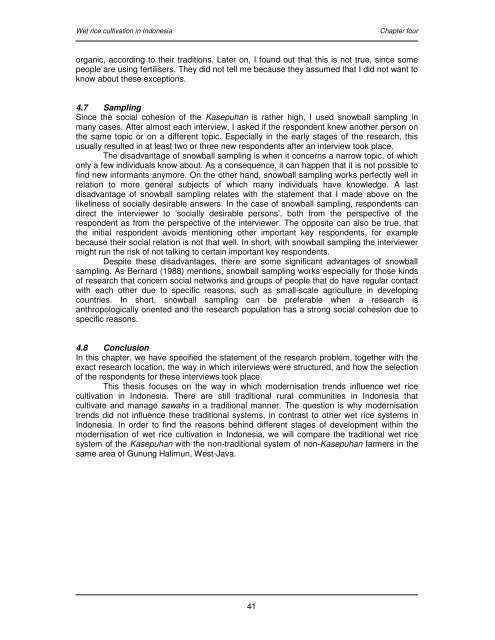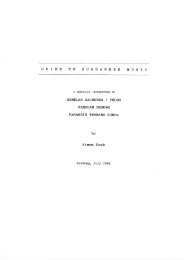Wet rice cultivation in Indonesia - Free EBooks Library
Wet rice cultivation in Indonesia - Free EBooks Library
Wet rice cultivation in Indonesia - Free EBooks Library
You also want an ePaper? Increase the reach of your titles
YUMPU automatically turns print PDFs into web optimized ePapers that Google loves.
<strong>Wet</strong> <strong>rice</strong> <strong>cultivation</strong> <strong>in</strong> <strong>Indonesia</strong> Chapter four<br />
organic, accord<strong>in</strong>g to their traditions. Later on, I found out that this is not true, s<strong>in</strong>ce some<br />
people are us<strong>in</strong>g fertilisers. They did not tell me because they assumed that I did not want to<br />
know about these exceptions.<br />
4.7 Sampl<strong>in</strong>g<br />
S<strong>in</strong>ce the social cohesion of the Kasepuhan is rather high, I used snowball sampl<strong>in</strong>g <strong>in</strong><br />
many cases. After almost each <strong>in</strong>terview, I asked if the respondent knew another person on<br />
the same topic or on a different topic. Especially <strong>in</strong> the early stages of the research, this<br />
usually resulted <strong>in</strong> at least two or three new respondents after an <strong>in</strong>terview took place.<br />
The disadvantage of snowball sampl<strong>in</strong>g is when it concerns a narrow topic, of which<br />
only a few <strong>in</strong>dividuals know about. As a consequence, it can happen that it is not possible to<br />
f<strong>in</strong>d new <strong>in</strong>formants anymore. On the other hand, snowball sampl<strong>in</strong>g works perfectly well <strong>in</strong><br />
relation to more general subjects of which many <strong>in</strong>dividuals have knowledge. A last<br />
disadvantage of snowball sampl<strong>in</strong>g relates with the statement that I made above on the<br />
likel<strong>in</strong>ess of socially desirable answers. In the case of snowball sampl<strong>in</strong>g, respondents can<br />
direct the <strong>in</strong>terviewer to ‘socially desirable persons’, both from the perspective of the<br />
respondent as from the perspective of the <strong>in</strong>terviewer. The opposite can also be true, that<br />
the <strong>in</strong>itial respondent avoids mention<strong>in</strong>g other important key respondents, for example<br />
because their social relation is not that well. In short, with snowball sampl<strong>in</strong>g the <strong>in</strong>terviewer<br />
might run the risk of not talk<strong>in</strong>g to certa<strong>in</strong> important key respondents.<br />
Despite these disadvantages, there are some significant advantages of snowball<br />
sampl<strong>in</strong>g. As Bernard (1988) mentions, snowball sampl<strong>in</strong>g works especially for those k<strong>in</strong>ds<br />
of research that concern social networks and groups of people that do have regular contact<br />
with each other due to specific reasons, such as small-scale agriculture <strong>in</strong> develop<strong>in</strong>g<br />
countries. In short, snowball sampl<strong>in</strong>g can be preferable when a research is<br />
anthropologically oriented and the research population has a strong social cohesion due to<br />
specific reasons.<br />
4.8 Conclusion<br />
In this chapter, we have specified the statement of the research problem, together with the<br />
exact research location, the way <strong>in</strong> which <strong>in</strong>terviews were structured, and how the selection<br />
of the respondents for these <strong>in</strong>terviews took place.<br />
This thesis focuses on the way <strong>in</strong> which modernisation trends <strong>in</strong>fluence wet <strong>rice</strong><br />
<strong>cultivation</strong> <strong>in</strong> <strong>Indonesia</strong>. There are still traditional rural communities <strong>in</strong> <strong>Indonesia</strong> that<br />
cultivate and manage sawahs <strong>in</strong> a traditional manner. The question is why modernisation<br />
trends did not <strong>in</strong>fluence these traditional systems, <strong>in</strong> contrast to other wet <strong>rice</strong> systems <strong>in</strong><br />
<strong>Indonesia</strong>. In order to f<strong>in</strong>d the reasons beh<strong>in</strong>d different stages of development with<strong>in</strong> the<br />
modernisation of wet <strong>rice</strong> <strong>cultivation</strong> <strong>in</strong> <strong>Indonesia</strong>, we will compare the traditional wet <strong>rice</strong><br />
system of the Kasepuhan with the non-traditional system of non-Kasepuhan farmers <strong>in</strong> the<br />
same area of Gunung Halimun, West-Java.<br />
41








